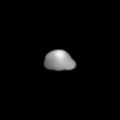22 Kalliope facts for kids
| Discovery | |
|---|---|
| Discovered by | John Russell Hind |
| Discovery date | November 16, 1852 |
| Designations | |
| none | |
| Main belt | |
| Orbital characteristics | |
| Epoch November 12, 2005 (JD 2453686.5) | |
| Aphelion | 479.931 Gm (3.208 AU) |
| Perihelion | 390.433 Gm (2.610 AU) |
| 435.182 Gm (2.909 AU) | |
| Eccentricity | 0.103 |
| 1812.245 d (4.96 a) | |
|
Average orbital speed
|
17.42 km/s |
| 303.545° | |
| Inclination | 13.710° |
| 66.240° | |
| 356.172° | |
| Physical characteristics | |
| Dimensions | 215×180×150 km |
| Mass | 6.3 ± 0.5 ×1018 kg |
|
Mean density
|
2.03 ± 0.16 g/cm³ |
| 0.038 m/s² | |
| 0.09 km/s | |
| 0.1728 d (4.148 h) | |
| Albedo | 0.142 |
| Temperature | ~161 K max: 240 K (-32°C) |
|
Spectral type
|
M |
| 6.45 | |
22 Kalliope is a big main belt asteroid of the M-type, found by J. R. Hind on November 16, 1852. It is named after Calliope, the Greek Muse of epic poetry.
Contents
Characteristics
Kalliope is about 180 km in diameter but is not perfectly round, as shown by images from the VLT at the European Southern Observatory
Its spectrum is M-type, but Kalliope does not appear to be metallic. It is similar to other M-types such as 21 Lutetia. Firstly, its density is far too low to be metal. Second, spectroscopic studies have shown evidence of hydrated minerals and silicates, so the surface is probably stony. Kalliope also has a low radar albedo, unlike most metallic surfaces.
Lightcurve analysis indicates that Kalliope's pole most likely points towards ecliptic coordinates (β, λ) = (-23°, 20°) with a 10° uncertainty, which gives Kalliope an axial tilt of 103°. Kalliope's rotation is then a bit retrograde.
Moon
Kalliope has one known moon, Linus, or (22) Kalliope I Linus. It is quite big: 30–40 km in diameter. It orbits about 1065 km from Kalliope. This is about 12 times the radius of Kalliope. Linus was found on August 29, 2001 by Jean-Luc Margot and Michael E. Brown, while another team also independently found the moon 3 days later.
Images for kids
See also
 In Spanish: (22) Kalliope para niños
In Spanish: (22) Kalliope para niños


